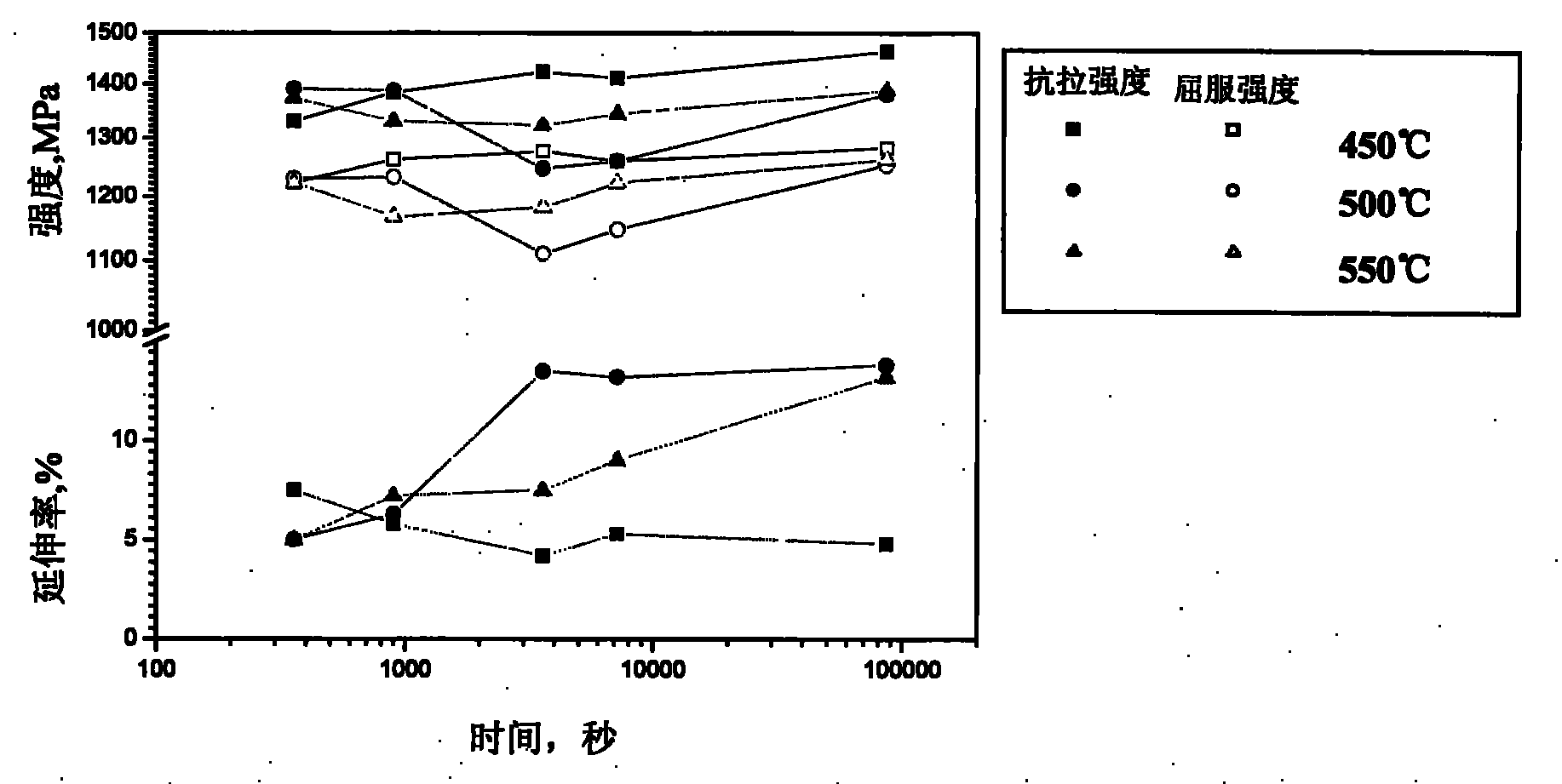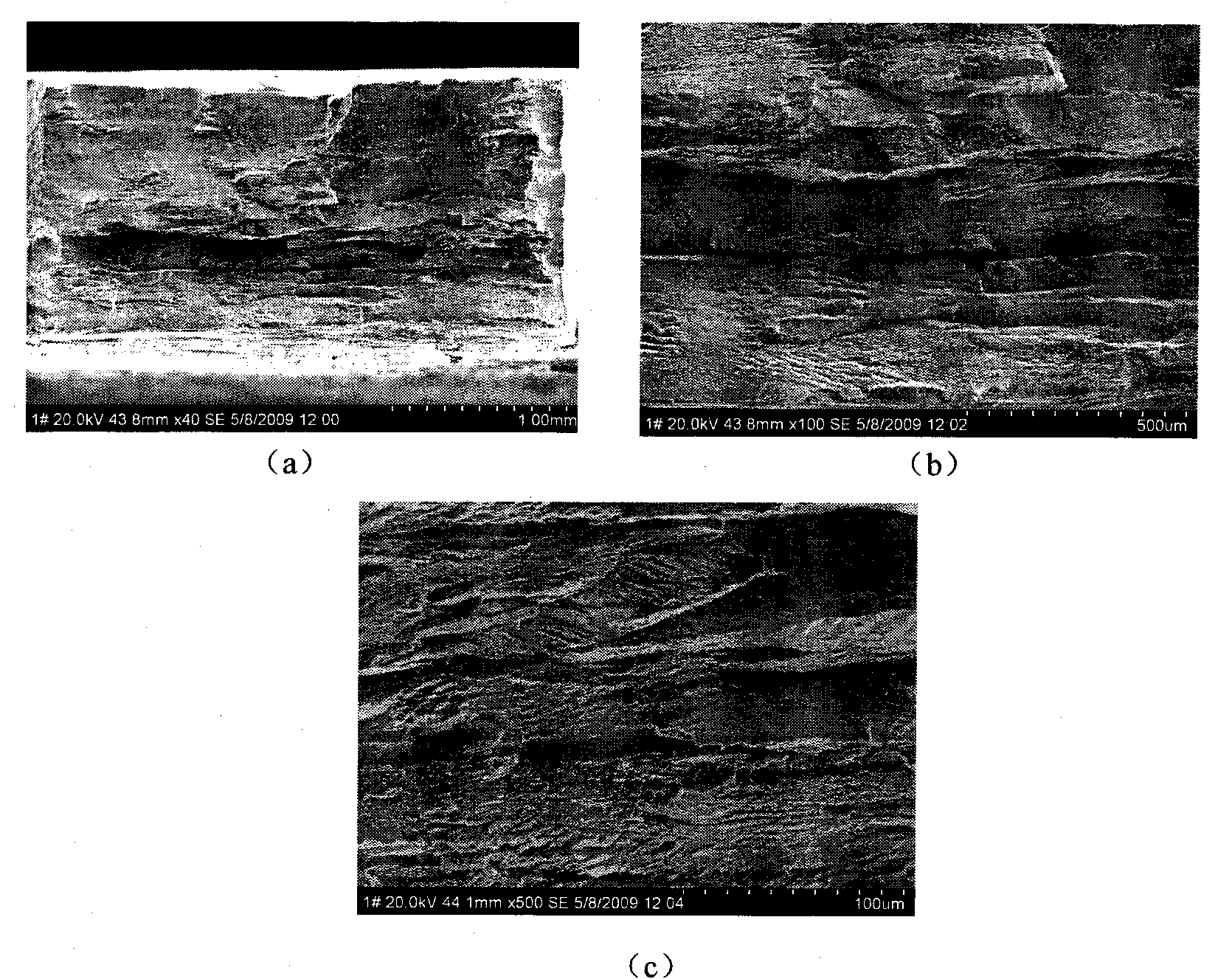Deformation induced maraging stainless steel and machining process thereof
A processing technology and stainless steel technology, which is applied in the field of iron-nickel-based martensitic precipitation hardening alloy, can solve the problems of only reaching the highest strength and low toughness, achieve high strength, high corrosion resistance, and improve the effect of strength and plasticity
- Summary
- Abstract
- Description
- Claims
- Application Information
AI Technical Summary
Problems solved by technology
Method used
Image
Examples
Embodiment 1
[0035] According to the following nominal composition (weight percent): C: 0.005%, Cr: 11.96%, Ni: 13.3%, Ti: 2.07%, Mo: 0.51%, Cu: 0.54%, Co: 1.72%, Nb: 0.006%, Mn: 0.60%, Si: 0.32%, V: 0.005%, Al: 1.4%, N: 0.004%, and Fe: balance. After mixing, put it into a vacuum induction furnace for melting. After smelting, the ingot is then subjected to thermal processing and heat treatment according to the following process conditions:
[0036] (1) Heated forging in the austenitic single-phase zone, the forging-pressure ratio is 7, and air-cooled to room temperature after forging;
[0037] (2) Hot rolling after forging, the initial rolling temperature is 1150°C, the final rolling temperature is 800°C, air-cooled to room temperature after rolling, and the cumulative reduction of hot rolling reaches 84%; in this embodiment, hot rolling is carried out in seven passes, The reduction per pass is 12%.
[0038] (3) cold-rolling the plate after hot-rolling, and the cold-rolling deformation is...
Embodiment 2
[0043] The difference from Example 1 is that the content of some alloy elements is adjusted, and the type and quantity of precipitated phases are changed, so as to obtain mechanical properties different from Example 1.
[0044] According to the following nominal composition (weight percent): C: 0.0065%, Cr: 11.90%, Ni: 11.9%, Ti: 1.62%, Mo: 0.52%, Cu: 2.09%, Co: 2.11%, Nb: 0.003%, Mn: 0.61%, Si: 0.82%, Al: 2.0%, V: 0.0024%, N: 0.005%, and Fe: balance. After mixing, put it into a vacuum induction furnace for melting. The ingot after smelting is subjected to thermal processing and heat treatment according to the process conditions described in Example 1.
[0045] The material was processed into samples after cold rolling and heat treatment, and its room temperature tensile properties, fracture toughness and corrosion resistance were tested respectively, and the tensile fracture was observed by scanning electron microscope. Metallographic structure after cold rolling Figure 4...
Embodiment 3
[0048] The difference from Example 1 and Example 2 is that the cold deformation reduction is adjusted based on the experience of the previous two examples to obtain better mechanical properties than those of Example 1 and Example 2.
[0049] According to the materials described in Example 1 and Example 2, after hot rolling is carried out according to the process conditions described in Example 1, the reduction is reduced from 60% to 40% during cold rolling, and then the sample after cold rolling is 1150 ° C. Solution treatment / 2h / oil quenching to room temperature, then aging treatment at 550°C for 24 hours, then air cooling.
[0050] The materials were processed into samples after heat treatment, and their tensile properties at room temperature were tested respectively.
[0051] Tensile results show that the mechanical properties of the material in Example 1 at room temperature are: the tensile strength is 1410MPa, the yield strength is 1320MPa, the elongation is 24.3%, and th...
PUM
| Property | Measurement | Unit |
|---|---|---|
| Strength | aaaaa | aaaaa |
| Fracture toughness | aaaaa | aaaaa |
| Tensile strength | aaaaa | aaaaa |
Abstract
Description
Claims
Application Information
 Login to View More
Login to View More - R&D
- Intellectual Property
- Life Sciences
- Materials
- Tech Scout
- Unparalleled Data Quality
- Higher Quality Content
- 60% Fewer Hallucinations
Browse by: Latest US Patents, China's latest patents, Technical Efficacy Thesaurus, Application Domain, Technology Topic, Popular Technical Reports.
© 2025 PatSnap. All rights reserved.Legal|Privacy policy|Modern Slavery Act Transparency Statement|Sitemap|About US| Contact US: help@patsnap.com



